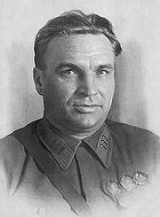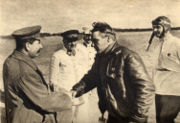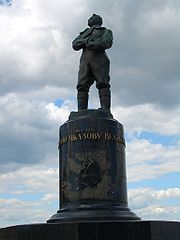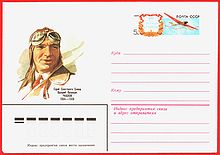
Valery Chkalov
Encyclopedia
Valery Pavlovich Chkalov (February 2, 1904 – December 15, 1938) was a Russia
n aircraft test pilot and a Hero of the Soviet Union
(1936).
but later returned to work as an apprentice with his father and as a stoker on river boats. He saw his first plane in 1919 and decided to join the Red Army's air force. He trained as a pilot and graduated in 1924 joining a fighter squadron. Chkalov married Olga Orekova in 1927. In the early 1930s he became a test pilot.
. In 1936 and 1937, he participated in several ultra long flights, including a 63-hour flight from Moscow
, Soviet Union
to Vancouver, Washington
, United States
via the North Pole
on an Tupolev ANT-25
plane (June 18–20, 1937), a non-stop distance of 8811 kilometres (5,474.9 mi). The flight pioneered the polar air route from Europe to the American Pacific Coast.
Aviation, specifically, was poised to positively affect public spirit. Firstly, tsarist Russia had not possessed a significant air force, meaning any successes in aviation could be wholly attributed “to the virtues of Bolshevism.” Furthermore, the successes of Soviet pilots (which the Soviet press publicized widely) offered the populace a feeling of technological superiority over both the world around them and Nature itself.
Stalin felt that exalting individual pilots was not dangerous to his own political interests because although the skill, strength, fortitude, etc., of the pilots were praised, Stalin was held as “ultimately responsible” for their achievements. The public narratives took pains to emphasize the father-son relationship between Stalin and his pilots. For example, Chakalov published an article titled “Our Father” soon after becoming the first person to fly from Moscow to the United States via a polar route. In this article, he explicitly stated that “[h]e[, Stalin,] is our father.” Stalin’s role as a paternal figure (and the implied nature of the pilots as his ‘spiritual sons’) emphasized that ultimate responsibility for the pilots’ feats lay with Stalin. This point was driven home by “accounts [which]…credit Stalin with much of the initiative and planning of [important flights, including, but not limited to] listening carefully to the ideas of Soviet aviators and aviation planners, tracing [the pilots’] routes, determining who [would] fly, and...giving the final permission.” Furthermore, the most prominent Soviet pilots (the ones around whom mini personality cults developed) enjoyed personal success, including compensation and other perks, within the structure of the USSR because of their successes in aviation. They thus had a strong incentive to remain publicly loyal to the regime. Stalin wished to use this system of glorifying pilots as a vehicle for promoting a type of role model to the people of the Soviet Union. The public identities of the USSR’s hero-pilots were to serve as representatives of Stalin’s conception of the New Soviet Man – someone beyond the petty machinations of politics - rather, someone who was a master of nature and an “eternally youthful…individual hero.”
The role Soviet pilots played in Soviet society was not solely constructive – they also served to distract. Some of the most high-profile flights Soviet pilots undertook coincided with the purges. Praise for both the victorious pilots – and, thus, Stalin – hit a fever pitch at just the moment the multitudes unfortunate enough to fall victim to the purges needed both the sympathy of the public and a thorough, unbiased examination of that which they had been accused. Distraction turned to a full assault for those more well-known victims of the purges who could not be simply swept under the carpet. Such unfortunates were instead subjected to unfavorable comparison with the pilots.
Again, fortunately for Chkalov, he had the honor of being “the Soviet Union’s most famous pilot.” Chkalov’s life story (as the government chose to represent it) reflects the traits of Stalin’s New Soviet Man – apolitical, forever young (he died in an accident at the age of thirty-four), a master of nature, and as concerned with the greater good (the integrity of his experimental aircraft) as he was with his own life. Interestingly, the government chose to highlight Chaklov’s personal initiative (that is, his youthful disdain for authority) – a peculiar sort of dualism in a society where the collective good was (supposed to be) prized over individual initiative. As John McCannon writes, “Chkalov was a brilliant instinctual flier, preferring to rely on hunches and reflex rather than standard methodology or flying instruments. He was also a daredevil who disdained authority.” The intended focus was not on youthful disobedience (for which, in canon, he was punished and apologized for), but on his use of his instincts. Chkalov, as a superman, could intuit towards the end of efficiency, something prized in the New Soviet Man. However, this intuitive strain was incomplete without a sense of “maturity and self-discipline.” One story in the public canon recounts how Chkalov tells a little boy he sees fighting a small girl to stop fighting and to focus his energy on his studies. The boy takes the advice to heart and is successful because of it. The point of the story is to show that though Chkalov was a firebrand as a youth, “in becoming a hero, [he] had gained not only wisdom but the capacity to transmit that wisdom to others.” This unification of bravery and maturity was the model which Stalin wished to transmit as the ideal – his conception of the New Soviet Man.
 Chkalov was killed on 15 December 1938 while piloting a prototype of the Polikarpov I-180
Chkalov was killed on 15 December 1938 while piloting a prototype of the Polikarpov I-180
fighter, which crashed during a test flight. The series of events leading up to the crash is not entirely clear. Neither Polikarpov
nor Tomashevich approved the flight, and no one had signed a form releasing the prototype from the factory. In any event, Chkalov took off and made a low altitude circuit around the airfield. For the second circuit, Chkalov flew farther away, climbing to over 2,000 m (6,560 ft) even though the flight plan specifically forbade exceeding 600 m (1,970 ft). Chkalov apparently miscalculated his landing approach and came in short of the airfield, but when he attempted to correct his approach the engine cut out. Chkalov was able to avoid several buildings, but struck an overhead powerline. Chkalov was ejected from the cockpit, sustaining severe injuries and died two hours later.
The official government investigation concluded that the engine cut out because it became too cold in the absence of the cowl flaps. Others hypothesised that Chkalov had advanced the throttle too fast and thus flooded the engine. As a result of the crash, Tomashevich and several other officials, including Arms Industry Department director S. Belyakin, who urged the first flight, were immediately arrested. Years later, fellow test pilot Mikhail Gromov
blamed the designers for flawed engine cooling and Chkalov himself for deviating from the flight plan. Chkalov's son claimed that a plan to assassinate his father had been in the works in the months preceding his death, but the circumstances of the crash make foul play unlikely. Regardless, with Chkalov's death Polikarpov's reputation with Stalin suffered a blow from which he would never recover.
 The village of Vasilyevo where Chkalov was born is now the town of Chkalovsk
The village of Vasilyevo where Chkalov was born is now the town of Chkalovsk
(Nizhny Novgorod Oblast
). The city of Orenburg
bore the name Chkalov from 1938 to 1957. There used to be a Chkalov Street in Moscow
(part of Moscow's Garden Ring
), now renamed Zemlyanoy Val, there still exist its namesakes in Nizhny Novgorod
and several other Russian cities. A street in Vancouver, Washington
has borne the name Chkalov Drive since the 1970s
(Google map).
A Chapayev class cruiser
was named Chkalov but was renamed Komsomolets in 1958.
The metro rail systems of Moscow
, Saint Petersburg
and Nizhny Novgorod
each have a Chkalovskaya
station. Yekaterinburg Metro
is expected to have one by 2010 as well.

Russia
Russia or , officially known as both Russia and the Russian Federation , is a country in northern Eurasia. It is a federal semi-presidential republic, comprising 83 federal subjects...
n aircraft test pilot and a Hero of the Soviet Union
Hero of the Soviet Union
The title Hero of the Soviet Union was the highest distinction in the Soviet Union, awarded personally or collectively for heroic feats in service to the Soviet state and society.-Overview:...
(1936).
Early life
Chkalov was born in the town of Vasilyevo, near Nizhni Novgorod, the son of a boiler maker. His mother died when he was six years old. Chkalov studied in the technical school in CherepovetsCherepovets
Cherepovets is the largest city in Vologda Oblast, Russia, located on the bank of the Rybinsk Reservoir of the Sheksna River, a tributary of the Volga River. Population: 311,869 ; It is served by Cherepovets Airport.-Location:...
but later returned to work as an apprentice with his father and as a stoker on river boats. He saw his first plane in 1919 and decided to join the Red Army's air force. He trained as a pilot and graduated in 1924 joining a fighter squadron. Chkalov married Olga Orekova in 1927. In the early 1930s he became a test pilot.
Achievements
Chkalov developed several new figures of aerobaticsAerobatics
Aerobatics is the practice of flying maneuvers involving aircraft attitudes that are not used in normal flight. Aerobatics are performed in airplanes and gliders for training, recreation, entertainment and sport...
. In 1936 and 1937, he participated in several ultra long flights, including a 63-hour flight from Moscow
Moscow
Moscow is the capital, the most populous city, and the most populous federal subject of Russia. The city is a major political, economic, cultural, scientific, religious, financial, educational, and transportation centre of Russia and the continent...
, Soviet Union
Soviet Union
The Soviet Union , officially the Union of Soviet Socialist Republics , was a constitutionally socialist state that existed in Eurasia between 1922 and 1991....
to Vancouver, Washington
Vancouver, Washington
Vancouver is a city on the north bank of the Columbia River in the U.S. state of Washington. Incorporated in 1857, it is the fourth largest city in the state with a 2010 census population of 161,791 as of April 1, 2010...
, United States
United States
The United States of America is a federal constitutional republic comprising fifty states and a federal district...
via the North Pole
North Pole
The North Pole, also known as the Geographic North Pole or Terrestrial North Pole, is, subject to the caveats explained below, defined as the point in the northern hemisphere where the Earth's axis of rotation meets its surface...
on an Tupolev ANT-25
Tupolev ANT-25
The Tupolev ANT-25 was a Soviet long-range experimental aircraft which was also tried as a bomber. First constructed in 1933, it was used by the Soviet Union for a number of record-breaking flights.-History and records:...
plane (June 18–20, 1937), a non-stop distance of 8811 kilometres (5,474.9 mi). The flight pioneered the polar air route from Europe to the American Pacific Coast.
As Part of the Soviet 'Cult' of the Pilot
Fortunately for Chkalov, his professional career as a pilot coincided with a period of Soviet history when aviation’s prominence as a cultural symbol was second only to that of Stalin himself. During this era, the government of the Soviet Union lionized – in fact, almost deified – its pilots. This glorification applied to pilots in general but also tended to concentrate intensely around certain individuals deemed particularly exemplary. Stalin – a man noted for his paranoia towards anything he believed could possibly develop into a rival cult of personality – decided that deliberately elevating pilots to make them popular with the population at large posed no political risk to him or his government. Far from creating powerful, politically motivated people around whom dissatisfied Soviet citizens could gather, the motivation behind exalting the USSR’s pilots was twofold: 1) to raise the population’s morale, and, as a function of that 2) to strengthen the legitimacy and strength of rule of the heads of government.Aviation, specifically, was poised to positively affect public spirit. Firstly, tsarist Russia had not possessed a significant air force, meaning any successes in aviation could be wholly attributed “to the virtues of Bolshevism.” Furthermore, the successes of Soviet pilots (which the Soviet press publicized widely) offered the populace a feeling of technological superiority over both the world around them and Nature itself.
Stalin felt that exalting individual pilots was not dangerous to his own political interests because although the skill, strength, fortitude, etc., of the pilots were praised, Stalin was held as “ultimately responsible” for their achievements. The public narratives took pains to emphasize the father-son relationship between Stalin and his pilots. For example, Chakalov published an article titled “Our Father” soon after becoming the first person to fly from Moscow to the United States via a polar route. In this article, he explicitly stated that “[h]e[, Stalin,] is our father.” Stalin’s role as a paternal figure (and the implied nature of the pilots as his ‘spiritual sons’) emphasized that ultimate responsibility for the pilots’ feats lay with Stalin. This point was driven home by “accounts [which]…credit Stalin with much of the initiative and planning of [important flights, including, but not limited to] listening carefully to the ideas of Soviet aviators and aviation planners, tracing [the pilots’] routes, determining who [would] fly, and...giving the final permission.” Furthermore, the most prominent Soviet pilots (the ones around whom mini personality cults developed) enjoyed personal success, including compensation and other perks, within the structure of the USSR because of their successes in aviation. They thus had a strong incentive to remain publicly loyal to the regime. Stalin wished to use this system of glorifying pilots as a vehicle for promoting a type of role model to the people of the Soviet Union. The public identities of the USSR’s hero-pilots were to serve as representatives of Stalin’s conception of the New Soviet Man – someone beyond the petty machinations of politics - rather, someone who was a master of nature and an “eternally youthful…individual hero.”
The role Soviet pilots played in Soviet society was not solely constructive – they also served to distract. Some of the most high-profile flights Soviet pilots undertook coincided with the purges. Praise for both the victorious pilots – and, thus, Stalin – hit a fever pitch at just the moment the multitudes unfortunate enough to fall victim to the purges needed both the sympathy of the public and a thorough, unbiased examination of that which they had been accused. Distraction turned to a full assault for those more well-known victims of the purges who could not be simply swept under the carpet. Such unfortunates were instead subjected to unfavorable comparison with the pilots.
Again, fortunately for Chkalov, he had the honor of being “the Soviet Union’s most famous pilot.” Chkalov’s life story (as the government chose to represent it) reflects the traits of Stalin’s New Soviet Man – apolitical, forever young (he died in an accident at the age of thirty-four), a master of nature, and as concerned with the greater good (the integrity of his experimental aircraft) as he was with his own life. Interestingly, the government chose to highlight Chaklov’s personal initiative (that is, his youthful disdain for authority) – a peculiar sort of dualism in a society where the collective good was (supposed to be) prized over individual initiative. As John McCannon writes, “Chkalov was a brilliant instinctual flier, preferring to rely on hunches and reflex rather than standard methodology or flying instruments. He was also a daredevil who disdained authority.” The intended focus was not on youthful disobedience (for which, in canon, he was punished and apologized for), but on his use of his instincts. Chkalov, as a superman, could intuit towards the end of efficiency, something prized in the New Soviet Man. However, this intuitive strain was incomplete without a sense of “maturity and self-discipline.” One story in the public canon recounts how Chkalov tells a little boy he sees fighting a small girl to stop fighting and to focus his energy on his studies. The boy takes the advice to heart and is successful because of it. The point of the story is to show that though Chkalov was a firebrand as a youth, “in becoming a hero, [he] had gained not only wisdom but the capacity to transmit that wisdom to others.” This unification of bravery and maturity was the model which Stalin wished to transmit as the ideal – his conception of the New Soviet Man.
Death

Polikarpov I-180
The Polikarpov I-180 was a 1938 Soviet fighter aircraft prototype. It was the last attempt to extract performance from the basic Polikarpov I-16 design...
fighter, which crashed during a test flight. The series of events leading up to the crash is not entirely clear. Neither Polikarpov
Polikarpov
Polikarpov Design Bureau was a Soviet OKB for aircraft, led by Nikolai Nikolaevich Polikarpov. After his death on 30 July 1944 at the age of 52, his OKB was absorbed into Lavochkin, but with some of its engineers going to Mikoyan-Gurevich and its production facilities going to Sukhoi...
nor Tomashevich approved the flight, and no one had signed a form releasing the prototype from the factory. In any event, Chkalov took off and made a low altitude circuit around the airfield. For the second circuit, Chkalov flew farther away, climbing to over 2,000 m (6,560 ft) even though the flight plan specifically forbade exceeding 600 m (1,970 ft). Chkalov apparently miscalculated his landing approach and came in short of the airfield, but when he attempted to correct his approach the engine cut out. Chkalov was able to avoid several buildings, but struck an overhead powerline. Chkalov was ejected from the cockpit, sustaining severe injuries and died two hours later.
The official government investigation concluded that the engine cut out because it became too cold in the absence of the cowl flaps. Others hypothesised that Chkalov had advanced the throttle too fast and thus flooded the engine. As a result of the crash, Tomashevich and several other officials, including Arms Industry Department director S. Belyakin, who urged the first flight, were immediately arrested. Years later, fellow test pilot Mikhail Gromov
Mikhail Gromov (aviator)
Mikhail Mikhaylovich Gromov was a famous Russian aviator and Hero of the Soviet Union.On 12-14 July 1937, Mikhail Gromov, A. B. Yumashev and S. A...
blamed the designers for flawed engine cooling and Chkalov himself for deviating from the flight plan. Chkalov's son claimed that a plan to assassinate his father had been in the works in the months preceding his death, but the circumstances of the crash make foul play unlikely. Regardless, with Chkalov's death Polikarpov's reputation with Stalin suffered a blow from which he would never recover.
Commemoration

Chkalovsk, Russia
Chkalovsk is a town and the administrative center of Chkalovsky District of Nizhny Novgorod Oblast, Russia, situated on the right bank of the Volga River, northwest of Nizhny Novgorod. Population: -History:...
(Nizhny Novgorod Oblast
Nizhny Novgorod Oblast
Nizhny Novgorod Oblast is a federal subject of Russia . Its administrative center is the city of Nizhny Novgorod. Population: The oblast is crossed by the Volga River. Apart from Nizhny Novgorod's metropolitan area, the biggest city is Arzamas...
). The city of Orenburg
Orenburg
Orenburg is a city on the Ural River and the administrative center of Orenburg Oblast, Russia. It lies southeast of Moscow, very close to the border with Kazakhstan. Population: 546,987 ; 549,361 ; Highest point: 154.4 m...
bore the name Chkalov from 1938 to 1957. There used to be a Chkalov Street in Moscow
Moscow
Moscow is the capital, the most populous city, and the most populous federal subject of Russia. The city is a major political, economic, cultural, scientific, religious, financial, educational, and transportation centre of Russia and the continent...
(part of Moscow's Garden Ring
Garden Ring
The Garden Ring, also known as the "B" Ring , is a circular avenue around the central Moscow, its course corresponding to what used to be the city ramparts surrounding Zemlyanoy Gorod in the 17th century....
), now renamed Zemlyanoy Val, there still exist its namesakes in Nizhny Novgorod
Nizhny Novgorod
Nizhny Novgorod , colloquially shortened to Nizhny, is, with the population of 1,250,615, the fifth largest city in Russia, ranking after Moscow, St. Petersburg, Novosibirsk, and Yekaterinburg...
and several other Russian cities. A street in Vancouver, Washington
Vancouver, Washington
Vancouver is a city on the north bank of the Columbia River in the U.S. state of Washington. Incorporated in 1857, it is the fourth largest city in the state with a 2010 census population of 161,791 as of April 1, 2010...
has borne the name Chkalov Drive since the 1970s
(Google map).
A Chapayev class cruiser
Chapayev class cruiser
The Chapayev class were a group of cruisers built for the Soviet Navy during and after World War II. Seventeen ships were planned but only seven were actually started before the German invasion...
was named Chkalov but was renamed Komsomolets in 1958.
The metro rail systems of Moscow
Moscow Metro
The Moscow Metro is a rapid transit system serving Moscow and the neighbouring town of Krasnogorsk. Opened in 1935 with one line and 13 stations, it was the first underground railway system in the Soviet Union. As of 2011, the Moscow Metro has 182 stations and its route length is . The system is...
, Saint Petersburg
Saint Petersburg Metro
The Saint Petersburg Metro is the underground railway system in Saint Petersburg and Leningrad Oblast, Russia. It has been open since November 15, 1955.Formerly known as the V.I...
and Nizhny Novgorod
Nizhny Novgorod Metro
The Nizhny Novgorod Metro , formerly known as Gorky Metro is a rapid-transit system that serves the city of Nizhny Novgorod, Russia. Opened in 1985, it consists of 13 stations and is 15.3 kilometres long.-History:...
each have a Chkalovskaya
Chkalovskaya metro station
Chkalovskaya metro station may refer to:*Chkalovskaya , a metro station of the Moscow Metro, Moscow, Russia*Chkalovskaya , a station of the Nizhny Novgorod Metro, Nizhny Novgorod, Russia...
station. Yekaterinburg Metro
Yekaterinburg Metro
The Yekaterinburg Metro is a rapid transit system that serves the city of Yekaterinburg, Russia.-History:Yekaterinburg, formerly called Sverdlovsk, was always known as the informal capital of the Urals, a natural divide between Europe and Asia, between Siberia and the European Russia. The city...
is expected to have one by 2010 as well.

See also
- Pearson FieldPearson FieldPearson Field , is a city-owned public-use airport located one mile southeast of the central business district of Vancouver, a city in Clark County, Washington, United States....
Site of 1937 landing - Pearson Air MuseumPearson Air MuseumThe Pearson Air Museum is an aviation museum at Pearson Field in Vancouver, Washington, USA. The museum specializes in aircraft made before or during World War II. The displays are housed in the U.S.'s second oldest wooden aircraft hangar, built in 1918 and used as a hangar since 1921. During World...
- ChkalovskChkalovskChkalovsk may refer to:*Chkalovsk, Russia, a town in Nizhny Novgorod Oblast, Russia*Chkalovsk, Tajikistan*Kaliningrad Chkalovsk, a naval air base in Kaliningrad Oblast, Russia...
, Places named after Chkalov - Chkalov IslandChkalov IslandChkalov Island , formerly Udd Island , is a coastal island in the southern end of the Sea of Okhotsk. It is located off Schastya Bay, between the shorebound lagoon and the sea. Baydukov Island lies only 2 km off its ESE tip.Chkalov Island is long and narrow...

